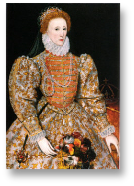
© Graham Watson


Experts now agree that the Great Bed of Ware was built around 1590 in the reign of Queen Elizabeth I. It was most probably an advertising ‘gimmick’ to draw travellers to the town after a possible drop in numbers of visitors when Catholics were no longer making pilgrimages to the shrine at Walsingham, Norfolk.
Although it was thought at one time to have been made for a grand local family, stylistic evidence suggests it was more likely to have been made for use in the apartments in the inns of Ware which were set apart for members of the Gentry. Made of oak with inlaid marquetry panels in its headboard and with carved ornament of grand but "not the highest order", it is described by the Victoria and Albert Museum as "middling grand". Apparently the grandest furniture was made out of walnut which is a less common wood than oak. The form and decoration indicates it dates from the reign of Queen Elizabeth 1 and was probably made sometime between 1570 and 1590.
Over the course of its long stay in Ware the Bed moved around between five inns, The W hite Hart, The George, The Crown, The Bull and the Saracen’s Head from which it was sold in 1870. Henry Teale took it to Rye House, Hoddesdon, as a visitor attraction.
hite Hart, The George, The Crown, The Bull and the Saracen’s Head from which it was sold in 1870. Henry Teale took it to Rye House, Hoddesdon, as a visitor attraction.
The most famous mention is made by Shakespeare's character Toby Belch in Twelfth Night which was first performed in 1601 '...and as many lies as will lie in thy sheet of paper, although the sheet were big enough for the bed of Ware in England...'. Ben Johnson also refers to it in 1609 in his play "Epicoene: or the Silent Woman".
The Great Bed spent 300 years in Ware from the time of the Spanish Armada, to the coming of the Railways. It was in Ware during the Industrial Revolution, the American War of Independence and so many other world changing events.
The Great Bed of Ware and its time in Ware
Queen Elizabeth 1
William Shakespeare